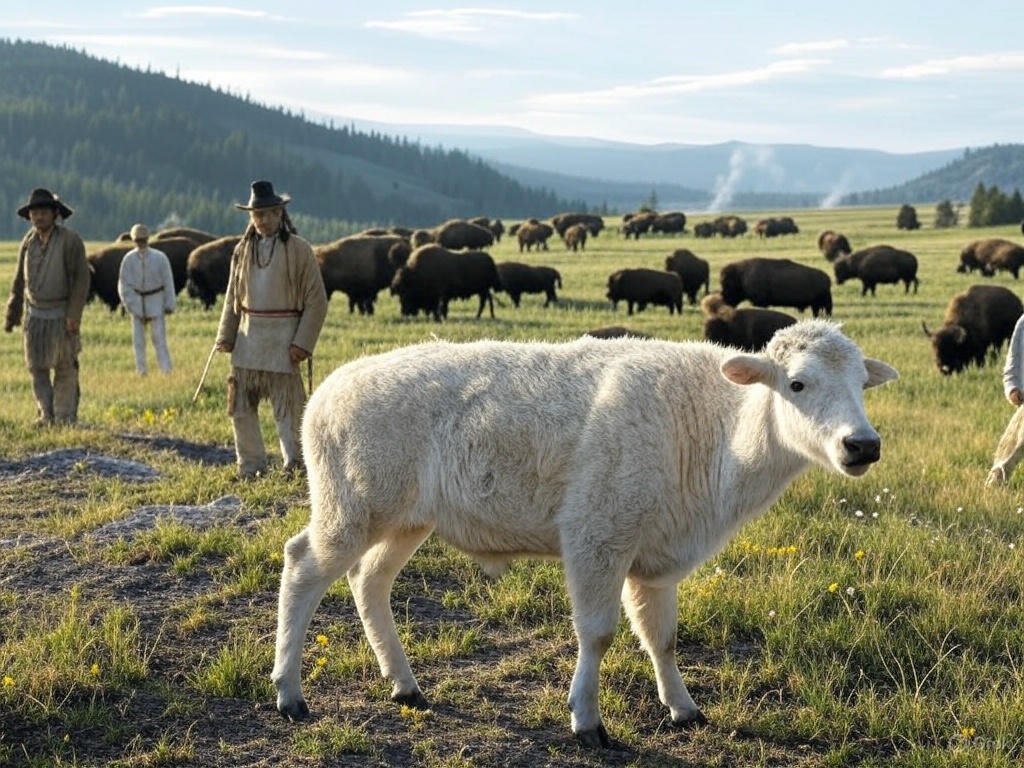In the summer of 2024, a rare white bison calf was born in Yellowstone National Park, an event that sent ripples of awe and reverence through Native American communities and beyond. Named Wakan Gli, or “Sacred Return,” by Lakota spiritual leaders, this calf is seen as a powerful symbol of hope, renewal, and spiritual awakening. The birth aligns with the ancient White Bison Prophecy, a sacred narrative held by many Plains tribes, including the Lakota, Cheyenne, and Arapaho. As we reflect in Spring 2025, following ceremonies honoring this event, the prophecy offers a profound lens into Native American spirituality and its enduring relevance.
The White Bison Prophecy: A Message of Balance
The White Bison Prophecy, as shared by Lakota elders, foretells the birth of a white bison calf as a sign of profound change. According to tradition, the calf’s arrival signals a time when humanity must restore balance with the natural world, honor the interconnectedness of all life, and heal divisions among people. The prophecy is tied to the story of White Buffalo Calf Woman, a sacred figure who brought the Lakota people the White Buffalo Calf Pipe and teachings for living in harmony.
Arvol Looking Horse, the 19th Keeper of the Sacred White Buffalo Calf Pipe, described the 2024 birth as a “call to action.” In a statement shared during a June 2024 ceremony, he emphasized that Wakan Gli’s arrival urges humanity to protect the Earth and respect Indigenous wisdom. For many tribes, the prophecy is not merely symbolic but a directive to address environmental crises, social injustices, and cultural erosion.
Read More: Yellowstone Bison Herd Lawsuit: Montana’s Legal Challenge to Park’s Management Plan
Wakan Gli: A Living Symbol
The birth of Wakan Gli captivated global audiences, with photos and videos circulating widely on platforms like X, where users shared stories of hope and prayers for renewal. Unlike albino bison, which lack pigmentation, Wakan Gli is a true white bison, a genetic rarity occurring in roughly one in ten million births. This distinction amplifies its sacredness, as the prophecy specifically refers to a non-albino white calf.
Lakota and Cheyenne tribal members held naming ceremonies in Yellowstone last summer, attended by hundreds, including conservationists and spiritual seekers. These gatherings underscored the calf’s role as a bridge between cultures, inviting non-Native people to engage respectfully with Indigenous perspectives. As Chief Arvol Looking Horse noted, “This is a time for all to come together, to listen to the Earth and to each other.”
Native American Perspectives on the Prophecy
For Native American communities, Wakan Gli’s birth is deeply personal. Rosalie Little Thunder, a Lakota elder and activist, shared in a 2024 interview that the calf represents “a reminder of our responsibilities as stewards of the land.” She highlighted the prophecy’s call for environmental protection, pointing to the ongoing threats to bison herds from habitat loss and climate change. “The white bison asks us to act, not just to marvel,” she said.
Other tribal voices emphasize the prophecy’s broader implications. Fred DuBray, a Cheyenne River Sioux Tribe member and bison rancher, sees Wakan Gli as a symbol of cultural revitalization. “Our young people are returning to ceremony, language, and the buffalo way of life,” he said in a recent X post. “This calf strengthens that momentum.”
Non-Native conservationists, such as those with the Buffalo Field Campaign, also recognize the calf’s significance. They advocate for protecting wild bison herds, aligning their efforts with the prophecy’s call for ecological balance. This convergence of Indigenous and conservationist priorities highlights the universal resonance of Wakan Gli’s message.
Read More: When Bison Charge: Unraveling Yellowstone’s 2024 Goring Incidents and Safety Must-Knows
Challenges and Controversies
While the birth of Wakan Gli has inspired many, it has also sparked challenges. Some non-Native visitors to Yellowstone have been criticized for seeking out the calf without understanding its cultural context, leading to overcrowding and stress on the park’s bison herds. Tribal leaders have urged respect for sacred sites and privacy during ceremonies, emphasizing that the prophecy is not a tourist attraction but a spiritual mandate.
Additionally, debates over bison management persist. Some ranchers view wild bison as a threat to cattle, while tribes and conservationists argue for their unrestricted roaming rights. The prophecy has amplified these discussions, with tribal advocates calling for policies that honor the bison’s sacred role.
A Call to Reflect and Act
As Spring 2025 unfolds, the birth of Wakan Gli remains a touchstone for reflection. The White Bison Prophecy invites us to consider our relationship with the Earth, each other, and the wisdom of Indigenous cultures. For those inspired to engage, tribal leaders suggest starting with education—learning about Native histories, supporting Indigenous-led conservation efforts, and advocating for policies that protect sacred lands and species.
The prophecy’s message is clear: Wakan Gli is not just a symbol but a catalyst. As Lakota elder Cheryl Angel stated during a 2024 ceremony, “The white bison is here to wake us up. Now, it’s on us to walk the path of healing.”
For readers eager to explore further, consider visiting tribal cultural centers, such as the Lakota Heritage Center in South Dakota, or supporting organizations like the InterTribal Buffalo Council. The story of Wakan Gli and the White Bison Prophecy is a living one, inviting all to listen, learn, and act in harmony with the Earth.

Felipe M Bastian is a seasoned wildlife conservation expert with a deep focus on Yellowstone National Park’s bison herd and its ecological, cultural, and legal complexities. With over a decade of experience in environmental policy and wildlife management, Felipe has worked closely with park authorities, tribal communities, and conservation organizations to advocate for sustainable bison management practices. His insights into the Yellowstone Bison Management Plan lawsuit, tribal relocation efforts, and bison safety protocols stem from extensive field research and collaboration with stakeholders. Felipe’s writing combines scientific rigor with accessible storytelling, making him a trusted voice on Yellowstone’s iconic species. He holds a Master’s degree in Wildlife Biology and is passionate about preserving the ecological and cultural legacy of bison for future generations.



